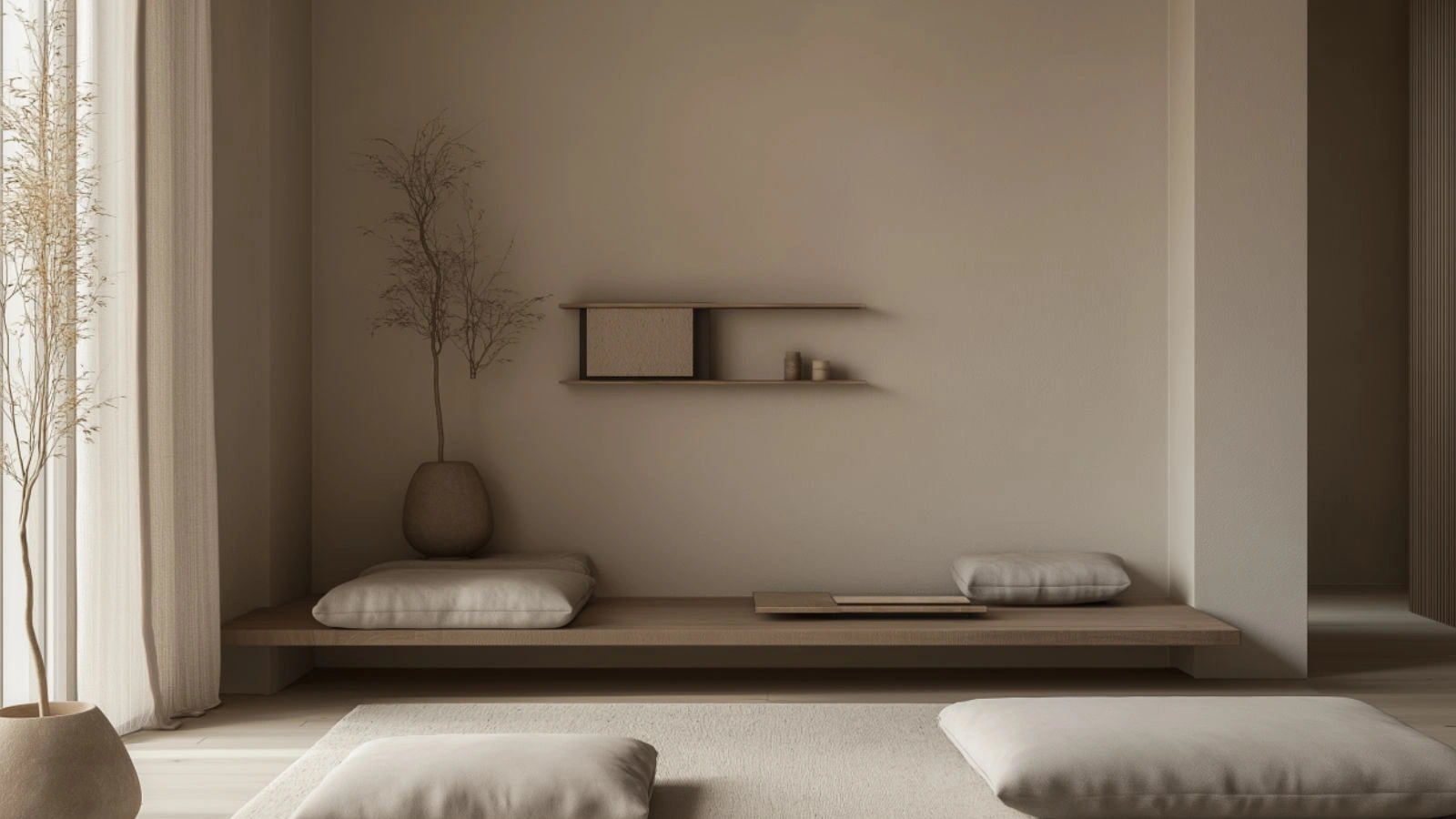Create Your Own Spiritual Room: Design Ideas for a Peaceful Retreat at Home
Table of Contents
In today’s fast-paced world, more people are turning inward—seeking moments of peace, clarity, and reconnection. According to interior wellness trends, dedicated spiritual spaces at home are becoming a growing priority. Whether it’s for daily meditation, prayer, journaling, or quiet reflection, a well-designed spiritual room offers a sanctuary where stress dissipates and healing begins.
Designing your own spiritual room isn’t about following strict decor rules. Instead, it’s about tuning in to what brings you peace. From selecting calming color palettes to adding meaningful objects and natural elements, this room becomes a physical extension of your inner world.
This guide will walk you through how to create a peaceful retreat in your home that nurtures the mind, body, and soul. You’ll explore intentional layout choices, mindful storage, natural materials, ambient lighting, and personal touches—all brought together to form your own sacred haven.
Whether you have an entire room or a corner to spare, these ideas will inspire you to design a tranquil space where you can reconnect with yourself and find moments of stillness.
Choosing the Right Location for Your Spiritual Room
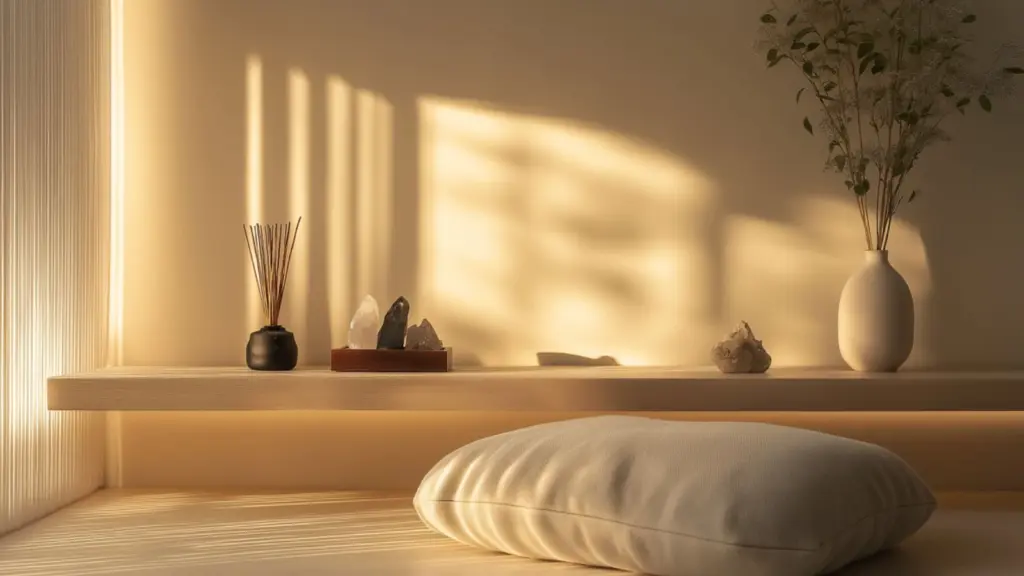
The first step to designing a spiritual room is selecting the right location. Ideally, the space should be quiet, private, and away from high-traffic zones in your home. A guest room, attic nook, or even a walk-in closet can be transformed into a peaceful sanctuary.
Natural light is a bonus—sunlight has a direct impact on mood and energy. But if windows aren’t available, soft artificial lighting can still create a soothing ambiance. Look for a room with minimal noise pollution or one where you can easily block out distractions.
If space is limited, a small corner with a floor cushion, a shelf, and calming decor can work just as well. The key is consistency—returning to the same area each day strengthens your connection to the practice.
Table: Spiritual Room Location Ideas and Considerations
| Location Option | Ideal Traits |
|---|---|
| Spare bedroom | Quiet, private, natural light |
| Attic or loft | Secluded, full of character |
| Walk-in closet | Enclosed, great for meditation or reflection |
| Living room corner | Accessible, great for shared mindfulness |
| Sunroom | Naturally lit, great for plant integration |
Designing a Layout That Encourages Stillness
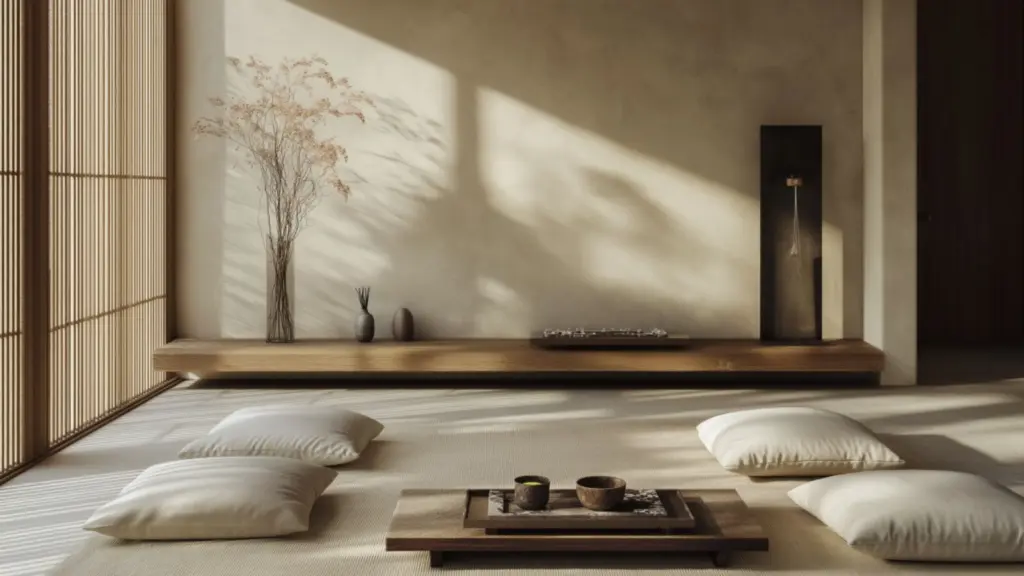
Layout plays a subtle yet powerful role in setting the tone of your spiritual room. Instead of traditional furniture arrangements, think of flow, simplicity, and energy.
Start with the foundation—consider a soft rug, meditation mat, or yoga floor space. Seating options should be low and grounded, such as a floor cushion, pouf, or bench. Avoid clutter and unnecessary furnishings; leave negative space to foster calm and clarity.
Your focal point might be a small altar, a spiritual statue, or a curated shelf with objects that inspire peace. Position it at eye level when seated and allow space around it for reverence.
Place practical items—like journals, singing bowls, or tarot decks—within easy reach in baskets or a low table. Arrange with symmetry if you crave balance, or asymmetrically for a more organic, fluid vibe.
Table: Layout Elements for a Peaceful Room Design
| Element | Purpose |
|---|---|
| Open floor space | Encourages stretching, yoga, or grounding |
| Low seating | Promotes stillness and rootedness |
| Visual focal point | Provides spiritual or meditative inspiration |
| Clear pathways | Allows flow and prevents visual clutter |
| Functional storage | Keeps tools accessible but hidden from sight |
Bringing Nature Inside for Grounded Energy
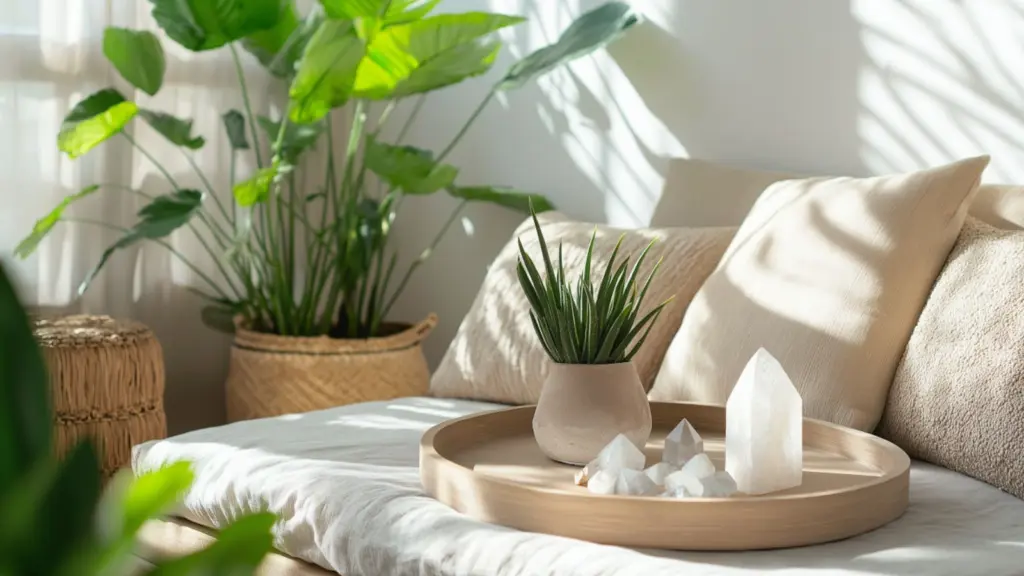
Nature is one of the most powerful ways to invite peace and balance into a space. In a spiritual room, natural elements serve as visual anchors, energetic purifiers, and symbolic reminders of the earth’s rhythms.
Start with indoor plants. Snake plants, pothos, ferns, and peace lilies are low-maintenance options that improve air quality while adding lush texture. Place them near windows or in corners to soften the lines of the room.
Incorporate natural materials through furniture and decor: think rattan baskets, wooden shelves, linen cushions, or stone bowls. These organic textures create warmth and depth.
Crystals and minerals are often used in spiritual spaces for their energetic properties. Amethyst promotes calm; clear quartz amplifies intention; rose quartz encourages self-love. Place them intentionally near your meditation area or on a small tray.
Sound elements, such as water fountains or wind chimes, can enhance the sensory experience and create a subtle, soothing soundscape.
Table: Natural Elements for a Peaceful Retreat
| Element | Benefit |
|---|---|
| Indoor plants | Air purification, connection to earth |
| Crystals | Energy alignment and spiritual intention |
| Wood or bamboo | Adds organic warmth and texture |
| Stones & minerals | Earthy grounding presence |
| Water features | Flow and tranquility through sound |
Choosing a Calming Color Palette
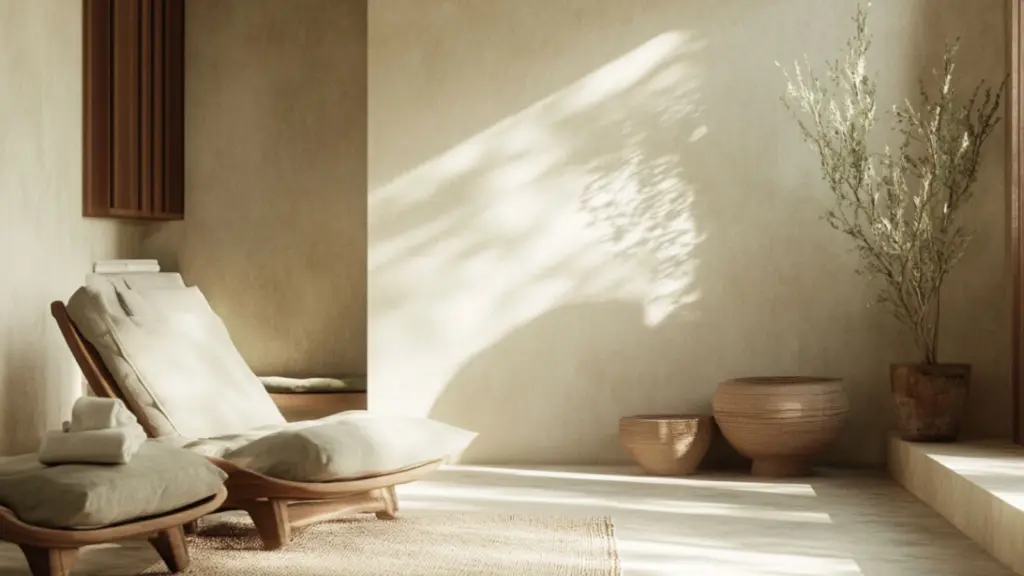
Color deeply influences mood, especially in a space designed for stillness and reflection. A spiritual room should favor hues that evoke peace, balance, and grounding energy.
Neutrals like warm white, soft taupe, beige, and dove gray create a gentle base that doesn’t overstimulate the senses. If you prefer a more immersive vibe, go for sage green, lavender, muted terracotta, or pale blue.
Stick to matte or flat finishes over gloss. These absorb light more softly, creating a cozier ambiance. If your room lacks natural light, choose warmer tones to compensate for the absence of daylight.
Incorporate accent colors through cushions, throws, curtains, or artwork. Limit the palette to three or four tones to keep the environment visually quiet.
Table: Calming Colors and Their Meanings
| Color Tone | Mood or Symbolism |
|---|---|
| Soft white | Clarity, openness, light |
| Sage green | Renewal, growth, groundedness |
| Pale blue | Tranquility, emotional peace |
| Dusty rose | Love, compassion, softness |
| Warm beige | Stability, earth connection |
Creating a Personalized Altar or Focal Area
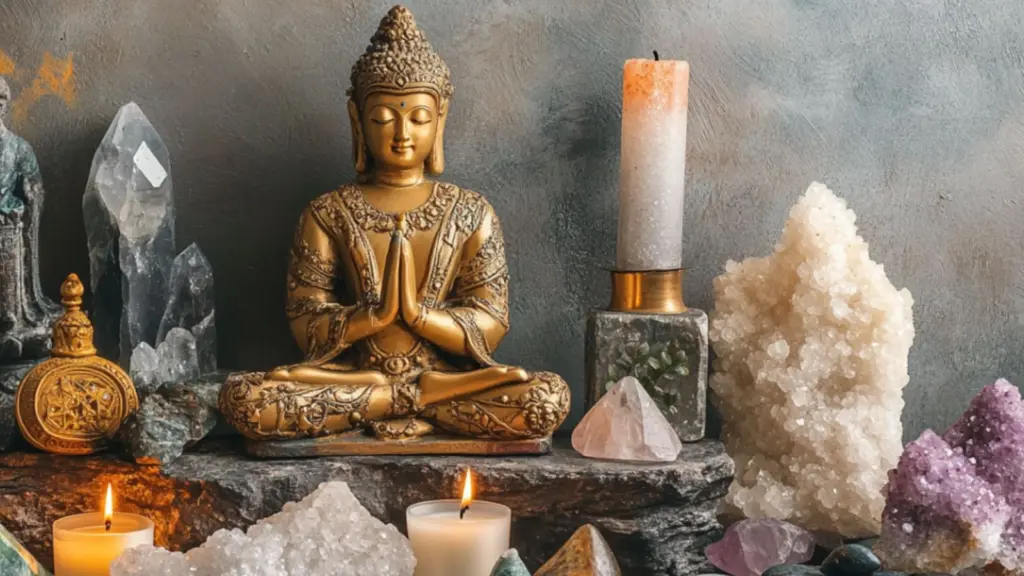
At the heart of many spiritual rooms is a personal altar or focal point—a visual and energetic centerpiece that helps center your practice. Whether it’s spiritual, meditative, or simply reflective, this area should feel deeply personal.
Start with a small table, floating shelf, or bench. Keep it simple. Cover it with a cloth made of linen, cotton, or velvet in a calming color. Then, layer in objects of personal or spiritual significance.
Popular items include candles, incense holders, crystals, spiritual books, affirmation cards, or symbolic statues (Buddha, deities, angels, or abstract forms). You can also add handwritten intentions, meaningful photos, or a journal.
The key is balance. Avoid crowding the space. Everything placed on the altar should resonate with your intention for the room—peace, protection, clarity, gratitude, or healing.
You can also rotate items seasonally or according to your emotional needs. Let the altar evolve with you.
Table: Personal Altar Setup Ideas
| Item Category | Examples |
|---|---|
| Light | Candle, lantern, fairy lights |
| Scent | Incense, essential oil diffuser |
| Symbolism | Crystals, statues, affirmations |
| Nature | Shells, leaves, stones, dried flowers |
| Personal Items | Journal, photos, mantra cards |
Incorporating Scent and Sound for a Multi-Sensory Space
Scent and sound are powerful mood shifters that can take your spiritual room to another level. They help you transition out of everyday busyness and into a quieter, more centered state.
For scent, consider incense, essential oil diffusers, beeswax candles, or even fresh herbs. Scents like lavender, sandalwood, frankincense, and cedar are known for their calming and grounding properties.
As for sound, think about soft instrumental music, nature sounds, or chimes. A Bluetooth speaker tucked subtly into the room can play meditative playlists, while a singing bowl or tuning fork can bring intentional vibration into the space.
Soundproofing your room with rugs, curtains, and cushions will also help absorb harsh noises and maintain your peaceful vibe.
Table: Scent and Sound Additions for Serenity
| Element | Recommendation |
|---|---|
| Essential Oils | Lavender, cedarwood, frankincense |
| Incense | Sandalwood, palo santo, myrrh |
| Music | Nature sounds, ambient, Tibetan bowls |
| Instruments | Singing bowls, wind chimes, tuning forks |
| Soundproofing | Soft textiles, rugs, wall hangings |
Conclusion
A spiritual room doesn’t require luxury materials or grand spaces—it simply requires intention. When thoughtfully designed, even the smallest corner can offer profound peace and presence.
Whether you’re beginning a meditation practice, seeking a space for prayer, or simply carving out a retreat from daily life, your spiritual room can become a sacred extension of yourself. Through calming colors, meaningful objects, natural elements, and a sense of flow, your home can hold a haven for stillness and healing.
Design with your soul in mind, and let your spiritual room remind you daily of the beauty of inner quiet.

